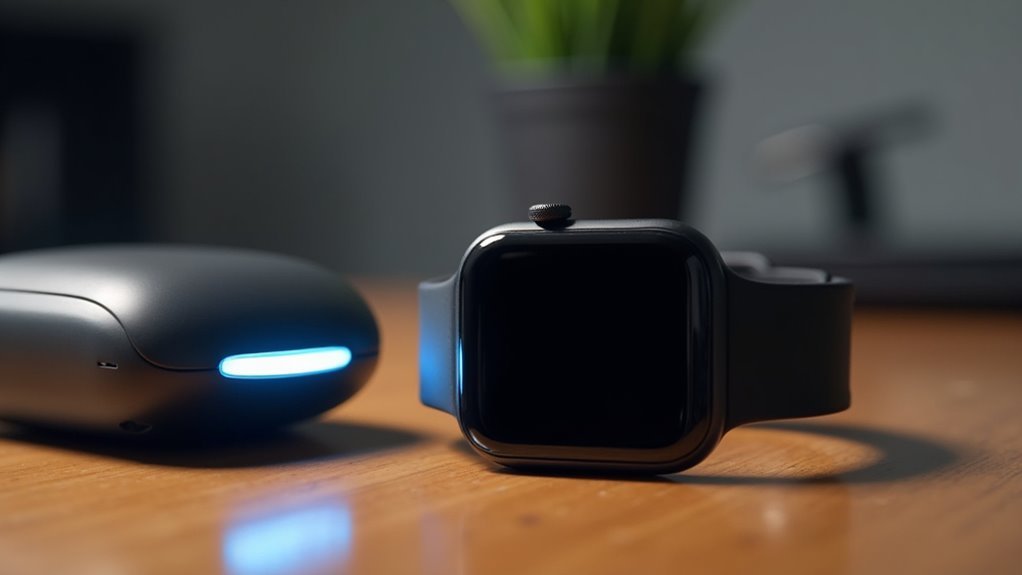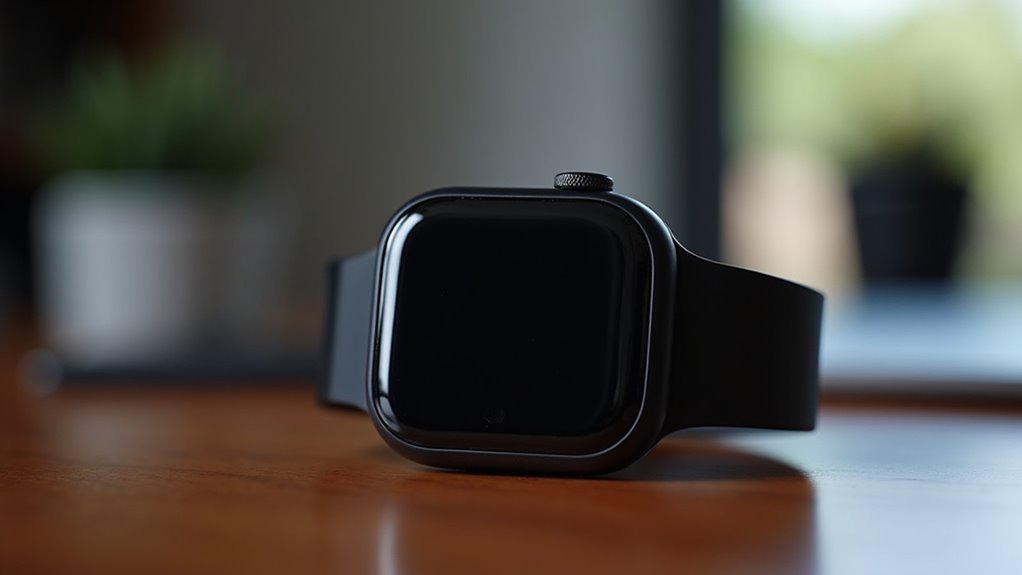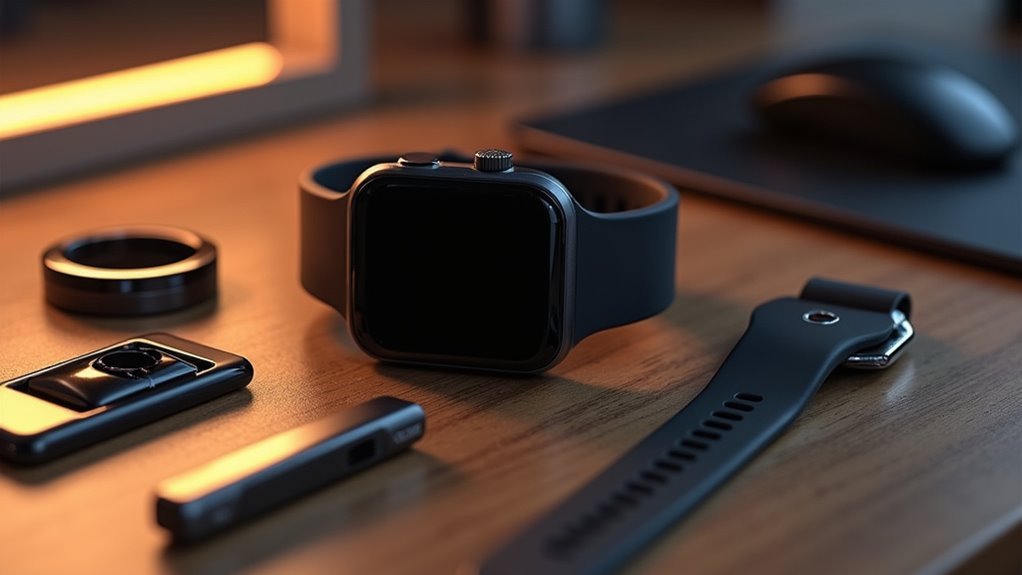You’ll revolutionize your enterprise security with contactless facial recognition smartwatches that authenticate users instantly, multi-modal biometric bands requiring both fingerprint and voice verification, and AI-powered threat detection watches that analyze behavioral patterns continuously. IoT-integrated wristbands offer RFID tracking and geofencing capabilities, while encrypted biometric wearables provide mobile MFA integration with EAL5+ certified security elements. These cutting-edge solutions eliminate password vulnerabilities, reduce fraud rates by 50%, and guarantee regulatory compliance while maintaining hygiene standards. Discover how these innovations can transform your organization’s security infrastructure.
Contactless Facial Recognition Smartwatches for Touch-Free Authentication

Three key innovations have transformed how enterprises approach secure authentication: contactless technology, advanced facial recognition, and wearable integration.
You’ll find contactless facial recognition smartwatches eliminate the need for physical touch while verifying your identity through unique facial features. These devices use onboard cameras and AI to process authentication instantly, delivering 15-18 verification events per minute.
Contactless facial recognition smartwatches deliver instant identity verification through AI-powered cameras, processing up to 18 authentications per minute without physical touch.
You can sync these smartwatches with your enterprise security systems via APIs or Bluetooth, enabling centralized access management. Unlike traditional activity trackers, they prioritize robust biometric authentication over fitness monitoring.
You’ll appreciate the streamlined workflow—simply look at your watch for immediate access. The system converts your facial features into an encrypted mathematical code that enables secure matching against stored templates. This technology reduces fraud risk, eliminates password vulnerabilities, and maintains hygiene standards critical in post-pandemic workplaces.
Multi-Modal Biometric Bands Combining Fingerprint and Voice Verification
You’ll find that multi-modal biometric bands offer considerably stronger security by requiring both fingerprint and voice verification before granting access to enterprise systems.
When you’re implementing these solutions, you’ll need to take into account integration complexity, user training requirements, and the substantial infrastructure changes required for deployment.
Your security team can measure effectiveness through false acceptance rates, authentication speed metrics, and user adoption statistics to guarantee the technology meets your organization’s protection standards. These wearable devices provide touchless authentication that improves hygiene while maintaining the highest levels of security verification.
Dual Authentication Technology Benefits
While traditional single-factor authentication leaves enterprises vulnerable to sophisticated cyber threats, multi-modal biometric bands that combine fingerprint and voice verification create an unprecedented level of security that’s virtually impossible to breach.
You’ll eliminate password dependency entirely, removing phishing and credential theft risks. The seamless authentication process streamlines your workforce’s access while maintaining near-zero failure rates. Your employees won’t need to remember passwords or manage tokens, reducing support calls and onboarding complexity.
| Security Advantage | Traditional Auth | Dual Biometric |
|---|---|---|
| Phishing Protection | Vulnerable | Nearly Impossible |
| Device Theft Risk | High Exposure | Biometric Required |
| Credential Sharing | Common Problem | Cannot Replicate |
This technology integrates easily with existing MFA systems and scales across enterprise environments, ensuring regulatory compliance while providing tamper-evident audit trails for investigations. With average recovery costs reaching $1.4 million per incident, these advanced biometric solutions provide critical protection against ransomware attacks that can cripple business operations.
Enterprise Implementation Strategies
Successfully deploying multi-modal biometric bands across your enterprise requires a strategic approach that addresses device integration, data processing architecture, and user adoption simultaneously.
You’ll need to integrate these wearables with your existing IT infrastructure and authentication protocols like FIDO standards to guarantee seamless scalability. Implement multi-factor authentication by combining biometric wearables with PINs or tokens to meet your security policies.
Focus on efficient provisioning workflows that handle simultaneous enrollment of fingerprint and voice modalities for streamlined user onboarding.
You’ll want to prioritize device-centric processing models that store data locally, enhancing privacy while reducing latency. Since liveness detection ensures the validity of biometric samples during remote enrollment and protects against spoofing attacks, incorporate these verification protocols into your wearable authentication system.
Plan for ongoing management including biometric template updates, device lifecycle oversight, and compliance with privacy regulations to maintain long-term security effectiveness.
Security Performance Metrics
When deploying multi-modal biometric bands that combine fingerprint and voice verification, measuring security performance requires tracking specific metrics that quantify both accuracy and resilience against threats.
You’ll need to monitor False Acceptance Rate (FAR), False Rejection Rate (FRR), and Equal Error Rate (EER) as your primary indicators. These metrics reveal how effectively your system prevents unauthorized access while maintaining user accessibility.
Your system’s robustness gets tested through its performance under varying environmental conditions like background noise or poor fingerprint capture quality. You should also track response times, as latency affects both security effectiveness and user experience.
Scalability metrics become essential when you’re deploying across large user bases. Don’t overlook continuous adaptation capabilities—your system must maintain performance as users’ biometric traits naturally change over time.
Additionally, implementing deepfake detection capabilities becomes critical as these sophisticated spoofing techniques pose significant threats to the integrity of voice biometric components in your multi-modal authentication system.
Palm Vein Scanning Wearables for High-Security Enterprise Access
As enterprises face increasingly sophisticated security threats, palm vein scanning wearables represent a cutting-edge solution that captures the unique vein patterns inside an individual’s palm using near-infrared light technology.
You’ll benefit from contactless, hygienic scanning that takes just seconds, making it perfect for fast-paced access points while reducing germ transmission risks.
These devices offer superior anti-spoofing capabilities since vein patterns remain invisible without specialized equipment. You can’t replicate or forge internal vein structures like surface biometrics such as fingerprints.
The technology integrates seamlessly into multifactor authentication frameworks with PIN codes or ID cards.
You’ll find applications spanning secure physical access to data centers, time tracking systems, enterprise payment authentication, and visitor management. Palm vein scanning delivers high accuracy with low false acceptance and rejection rates due to the uniqueness of individual vein patterns.
The contactless nature guarantees user comfort while providing tamper-proof access logs for regulatory compliance.
Ai-Powered Threat Detection Watches With Real-Time Security Monitoring

You’re moving beyond static authentication to dynamic security intelligence with AI-powered threat detection watches that continuously analyze behavioral patterns and environmental data.
These wearables don’t just verify your identity—they’re constantly learning your normal activities to spot anomalies that could signal security threats in real-time. Advanced systems employ multimodal approaches combining multiple biometric indicators for enhanced accuracy compared to single-factor authentication methods.
Your security team receives instant alerts when the AI detects unusual access patterns, unauthorized personnel movement, or potential breach attempts, transforming passive monitoring into proactive threat prevention.
Proactive Threat Detection Systems
While traditional security systems react to breaches after they occur, AI-powered threat detection watches revolutionize enterprise security by identifying and neutralizing threats before they can cause damage.
These sophisticated wearables continuously monitor your employees’ biometric data through real-time sensors, analyzing patterns to detect behavioral anomalies before security incidents unfold.
You’ll benefit from machine learning algorithms that process heart rate, gait, and facial recognition data to establish baseline behaviors.
When the system identifies deviations—such as stress indicators suggesting coercion or unusual movement patterns indicating unauthorized access—it instantly triggers automated security protocols.
Your organization can reduce fraud rates by up to 50% while preventing tailgating and insider threats through continuous behavioral analytics that work around the clock. These advanced systems enable 287-day response reduction by providing immediate threat detection compared to traditional security approaches that take months to identify breaches.
Real-Time Security Analytics
Real-time security analytics transforms threat detection from a reactive process into an immediate, intelligent response system that processes millions of data points every second.
Your biometric wearables continuously monitor behavioral patterns, environmental conditions, and physiological data to identify anomalies instantly. AI-powered algorithms analyze sensor data from motion detectors and environmental monitors, creating thorough threat profiles that adapt to emerging risks.
You’ll receive instant alerts when the system detects unusual patterns, enabling immediate security responses. The technology integrates seamlessly with your existing security infrastructure, providing customizable alert systems tailored to specific threats.
Machine learning models continuously evolve, improving accuracy through data integration from multiple sensors. Advanced solutions like Graboxy Sentinel can analyze cursor movements to provide continuous behavioral biometric authentication for enhanced account protection. This real-time approach enhances your authentication processes while maintaining operational efficiency and regulatory compliance requirements.
IoT-Integrated Biometric Wristbands for Smart Building Automation
IoT-integrated biometric wristbands represent a revolutionary leap in enterprise security, seamlessly merging personal identification with intelligent building systems.
You’ll benefit from RFID tracking, fingerprint recognition, and real-time health monitoring that automatically adjusts HVAC and lighting based on your presence. These devices eliminate physical keys while providing contactless authentication through wireless protocols like Bluetooth and Wi-Fi.
Your organization gains enhanced security through unique biometric markers that can’t be stolen or duplicated. The wristbands enable contact tracing, optimize resource management, and integrate with centralized building platforms for unified control. These systems utilize geofencing technology to create virtual boundaries that monitor employee movements and automatically trigger security protocols when personnel enter or exit designated areas.
You’ll experience faster access speeds and improved productivity while maintaining workforce health surveillance.
However, you must address data privacy concerns, guarantee interoperability with existing systems, and manage battery consumption for sustained operation.
Continuous Authentication Fitness Trackers for Mobile Workforce Security

As mobile workforces expand beyond traditional office boundaries, continuous authentication fitness trackers deliver persistent security verification that adapts to your team’s dynamic work environments.
These wrist-worn devices use PPG sensors, accelerometers, and ECG technology to monitor heart rate patterns and behavioral biometrics throughout entire work sessions. You’ll reduce session hijacking risks while providing hands-free authentication that doesn’t interrupt productivity.
Your mobile employees gain seamless access protection through passive monitoring that detects anomalies in real-time. When unauthorized users attempt device access, the system automatically triggers security protocols and locks critical applications. The integration with existing smartphone companion apps enables comprehensive data synchronization and centralized security management across your enterprise infrastructure.
You’ll enhance multi-factor authentication frameworks while maintaining detailed audit logs for compliance requirements. However, you must address privacy concerns around biometric data collection and guarantee BLE protocol security to protect against emerging attack vectors.
Encrypted Biometric Wearables With Mobile MFA Integration
When your enterprise deploys encrypted biometric wearables with mobile MFA integration, you’ll establish multiple layers of security that protect sensitive data through EAL5+ certified secure elements and FIDO2-compliant authentication protocols. These wearables utilize secure communication methods like NFC and BLE to connect with mobile devices, creating a seamless authentication experience.
| Biometric Modality | Security Benefit |
|---|---|
| Fingerprint Recognition | Passwordless authentication with spoofing prevention |
| Face & Voice Recognition | Enhanced phishing resistance through multi-factor verification |
| Gesture Recognition | Additional security layer with intuitive user control |
You’ll benefit from prompt-based authentication where users receive secure notifications on registered devices. The mobile device functions as a token, preventing fraudulent access if lost. This integration reduces costs while providing superior security compared to traditional methods, ensuring compliance with GDPR and HIPAA standards. Since over 90% of cyberattacks begin with phishing emails that target employees as the primary vulnerability, implementing phishing-resistant authentication becomes critical for preventing costly regulatory and financial impacts.
Frequently Asked Questions
What Happens to Biometric Data if the Wearable Device Is Lost or Stolen?
If you lose your wearable device, your biometric data becomes vulnerable to unauthorized access since it can’t be changed like passwords. Thieves can exploit this permanent data, potentially causing identity theft and security breaches.
How Long Do Biometric Wearable Batteries Typically Last Under Continuous Authentication Use?
You’ll typically get 12-36 hours of battery life during continuous authentication, considerably less than normal 1-3 day usage. Multiple sensors running constantly drain your wearable’s 200-500mAh battery much faster than standard operations.
Can Biometric Wearables Function Offline When Network Connectivity Is Temporarily Unavailable?
You’ll find biometric wearables work smoothly offline through local data processing and secure storage. They’ll authenticate you using stored biometric templates, ensuring you’re not locked out during network outages or connectivity issues.
What Are the Total Cost Implications of Enterprise-Wide Biometric Wearable Deployment?
You’ll face substantial costs including $15,000-50,000+ initial investment per site, plus 10-20% annual maintenance fees. Factor in installation, training, integration expenses, and ongoing support when budgeting your enterprise-wide biometric wearable deployment.
How Do Biometric Wearables Handle Authentication for Users With Physical Disabilities or Injuries?
You’ll find biometric wearables offer multiple authentication methods like voice, facial, and eye recognition for physical limitations. They integrate with assistive technologies, provide alternative options when initial verification fails, and minimize required physical interactions.
In Summary
You’re witnessing the future of enterprise security through these innovative biometric wearables. Each device offers unique advantages, from contactless authentication to continuous monitoring, helping you eliminate traditional security vulnerabilities. You’ll find these solutions particularly valuable as your workforce becomes increasingly mobile and distributed. Don’t wait to evaluate which combination of biometric wearables best fits your organization’s security requirements and operational needs.





Leave a Reply